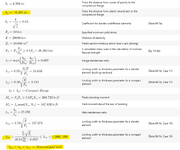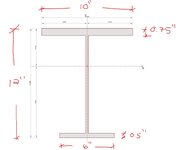RattlinBog
Structural
- May 27, 2022
- 185
TLDR: Risa-3D calculates hp as a negative number anytime the PNA is within the compression flange of a singly symmetric beam cross-section. This causes a noncompact web and messes up flexure Section F4 equations, reducing bending strength. AISC 360-16 (or -22).
Risa support confirmed that the below issue is an error in the program, and they have a ticket out to fix it. Risa-3D (v22.0 and earlier)
If you ever need to design a singly symmetric I-shaped beam with unequal flanges per AISC 360-16 (or -22) using Risa's "tapered WF" shape dialog or by importing a shape from RisaSection, then be aware of this issue.
In the uncommon scenario of having a cross-section with a plastic neutral axis (PNA) located within the compression flange, Risa-3D will calculate the variable hp to be a negative number, which is wrong. The variable hp is defined in AISC 360 as, "Twice the distance from the plastic neutral axis to the inside face of the compression flange."
The variable hp is needed to calculate the limiting width-to-thickness ratio, λpw, for Case 16 in AISC 360-16 Table B4.1b for the web of a singly symmetric I-shaped member. When hp is negative, λpw becomes a large negative number, which automatically classifies the web as noncompact. A negative λpw also causes issues in flexure Section F4 equations (F4-9b), (F4-13), and (F4-16b).
The AISC Specification commentary on Section F4 states this about hp: "Otherwise, in extreme cases where the plastic neutral axis is located in the compression flange, hp = 0 and the web is considered to be compact."
In my personal opinion, I think it's okay if hp is a positive, absolute value instead of 0. It just can't be negative. If it's 0, it causes a dividing by 0 issue in the λpw equation.
I compared a hypothetical test beam with a large compression flange in both Risa-3D and a comprehensive Mathcad worksheet I built:
Risa-3D: hp = -0.181", λpw = -2661.2, LRFD design bending strength = 151.4 kip-ft
Mathcad: hp = +0.181", λpw = 137.3, LRFD design bending strength = 183.2 kip-ft

Risa support confirmed that the below issue is an error in the program, and they have a ticket out to fix it. Risa-3D (v22.0 and earlier)
If you ever need to design a singly symmetric I-shaped beam with unequal flanges per AISC 360-16 (or -22) using Risa's "tapered WF" shape dialog or by importing a shape from RisaSection, then be aware of this issue.
In the uncommon scenario of having a cross-section with a plastic neutral axis (PNA) located within the compression flange, Risa-3D will calculate the variable hp to be a negative number, which is wrong. The variable hp is defined in AISC 360 as, "Twice the distance from the plastic neutral axis to the inside face of the compression flange."
The variable hp is needed to calculate the limiting width-to-thickness ratio, λpw, for Case 16 in AISC 360-16 Table B4.1b for the web of a singly symmetric I-shaped member. When hp is negative, λpw becomes a large negative number, which automatically classifies the web as noncompact. A negative λpw also causes issues in flexure Section F4 equations (F4-9b), (F4-13), and (F4-16b).
The AISC Specification commentary on Section F4 states this about hp: "Otherwise, in extreme cases where the plastic neutral axis is located in the compression flange, hp = 0 and the web is considered to be compact."
In my personal opinion, I think it's okay if hp is a positive, absolute value instead of 0. It just can't be negative. If it's 0, it causes a dividing by 0 issue in the λpw equation.
I compared a hypothetical test beam with a large compression flange in both Risa-3D and a comprehensive Mathcad worksheet I built:
Risa-3D: hp = -0.181", λpw = -2661.2, LRFD design bending strength = 151.4 kip-ft
Mathcad: hp = +0.181", λpw = 137.3, LRFD design bending strength = 183.2 kip-ft


